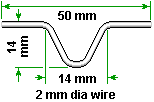| |
This product is not registered for use in the U.K.Gabon PA-92, Varroa treatment
General note on chemicals: I do not endorse or advise on chemical treatments, as I am not qualified to do so and there may be dangers beyond my control. New
products may be introduced or existing ones withdrawn, so it is difficult to keep up with current information on a website such as this. As many of the chemical pages were generated by Dave Cushman, I am leaving the
content mainly as left by Dave for historical purposes only, which may mean information is out of date and unreliable. The user should seek guidance from other sources and satisfy themselves regarding safety and legality.
Roger Patterson.
|
|---|
(Comments in brackets and this typeface are my
insertions/translations as the original document is a little
disjointed.)
Data Sheet Ref:- T602\LEKy\GA92_95A
Date of Issue of Data:- (Thought to be 1995 for the
leaflet with 1992 being product inception date.)
Ingredient: ACRINATHRINE, 1.2 - 1.7 mg in one strip
(I have an older copy of the leaflet that gives 1.0 - 1.5 mg
per strip. I think the change occurred about 1994/95, but I am not
certain.)
Properties and Effectiveness
Strip (carrier) (is made) from the gabon veneer
(it) contains (a polymer) mixture with
bound acarinathrine, which is released (by) diffusion in small
quantities to the strip surface. It is spread in the colony by
contact with the strip and by the mutual contact (between)
bees.
Mites from the brood cells are afflicted after the emerging of bees
at the contact with contaminated bees. The medicament is determined
for the protection of winter bees in the late summer and in autumn
in colonies with high intensity of varroasis. GABON PA-92 is not used
in the time of the reduced activities of bees (bees in winter
cluster). GABON PA-92 controls also bee lice. (Braula
assumed)
Technology (Method)
The bee colony is dismantled and two strips are hung into slightly
enlarged bee ways between brood combs symmetrically into the brood
body centre (for instance into the 2nd and the 5th bee way). Only
at very strong colonies which possess the brood in two boxes we hang
one or two strips more. Strips are hung on hooklets. One hooklet as a
sample is enclosed to each package of strips. The strip is to hang
freely between combs. It must not be disturbed.
Strips are left in the colony for two periods of sealed brood, i.e.
24 to 30 days. After this period strips are taken out. Strips may be
used repeatedly without losing the effectiveness. (I am not
sure that this is what the original translator meant to say... Please
exercise caution, it maybe should read do not re-use strips!)
Term of Cure (Season of Treatment)
Strips are used after the last honey extraction. (After supers
are removed.)
Safety Rules
Only (nitrile rubber) gloved hands handle the strips. If skin
is affected, it is washed with water and soap. Do not take meals,
drinks, do not smoke at the work. Store in a locked dry room
separately from food and feed. Strips are to be protected from fire,
light, frost.
If the application methods are kept, no danger of impairment of honey,
bee stores and beeswax.
Only on Vet prescription!
Packing: A packet contains 50 strips and 1 hooklet
(sample).

The 'hooklet' mentioned is
intended to be copied and used to hang all strips. It is also used
for other purposes in Czech bee medication. In use the strip is
threaded onto the dip and then lowered between two frames.
|
I neither endorse nor condemn this product. The information as published
here is a matter of public record. The information is placed here for
the education of those that wish to read it.
BEFORE you obtain or use the material concerned please ascertain the
legality of doing so in your location as the product may or may not be
approved in your geographic State or Country.
Further details Emailed after an enquiry about what the
active ingredient was...
Dear Dave,
Acrinathrin is a substance from the group of pyrythrans, which is
similar to pyrethroids.
Toxicological data for vertebrates are very good: LD 50 acute oral for
rats is higher than 5000 mg/kg, ADI for men is 0,02 mg/kg.
Acrinathrin shows high acaricide property in very low concentrations.
The dose of acrinathrin in one strip is less than 2 mg.
Acrinathrin is an active substance of GABON PA 92 strips, which are
produced in our Institute.
Best regards,
V. Vesely
Bee Research Institute at Dol
CZ 252 66 Libcice n.Vlt.
Czech Republic
Dave Cushman.
Originally written by Dave Cushman. Edited and additions by Roger Patterson.
Page created pre-2011
Page updated 12/12/2022
